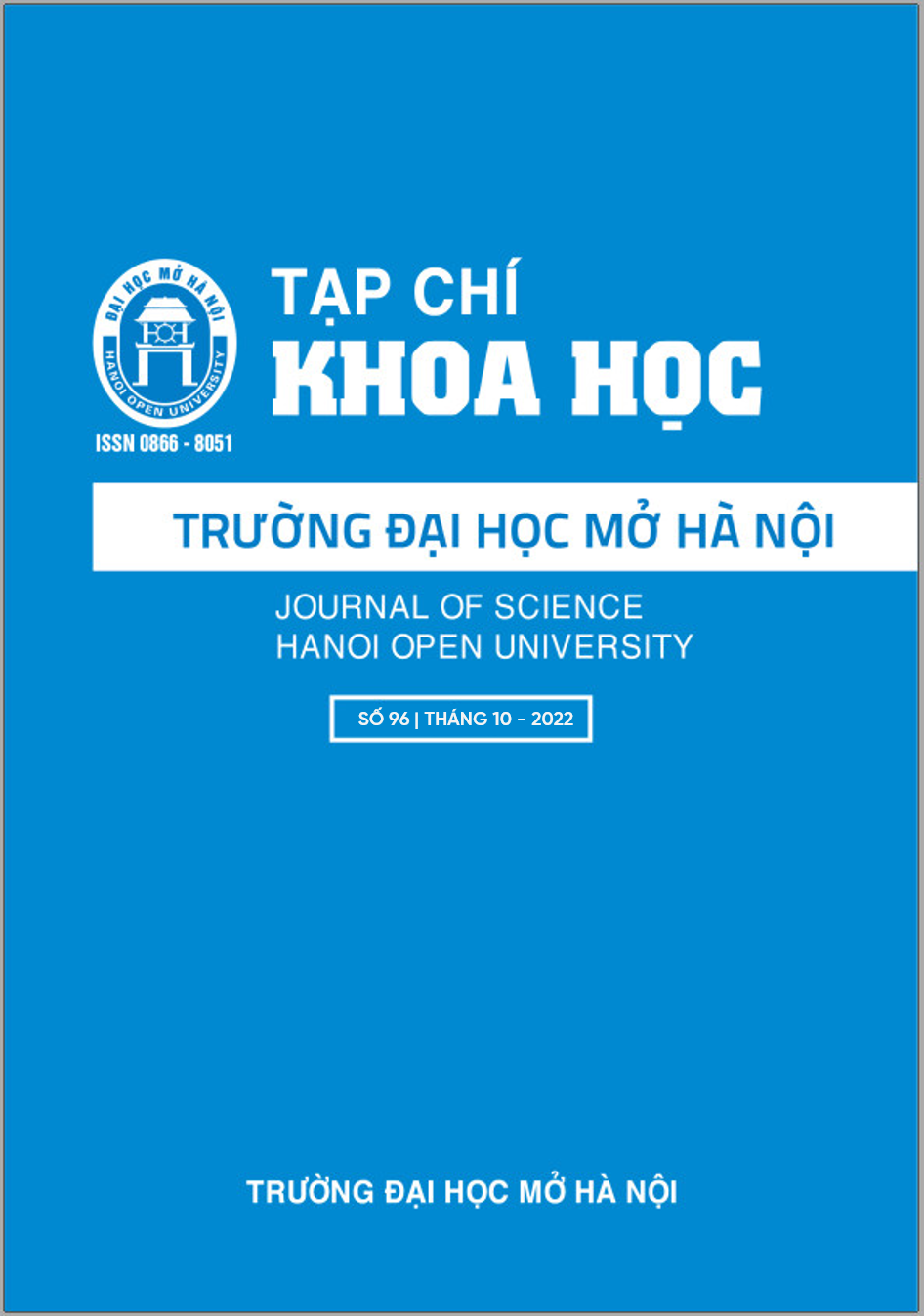LEARNING AUTONOMY: A CASE STUDY AT THE FACULTY OF ENGLISH, HANOI OPEN UNIVERSITY
Từ khóa:
learner autonomy, project-based learningTóm tắt
In Vietnam, learning activities are likely to be teacher-centered, in which teachers play the principal role in the teaching process. Project-based learning is an approach to enhance learner autonomy. Therefore, this paper reports the impact of project work in teaching English language skills to second-year students majoring in English at Hanoi Open University. Twenty-five second-year students who majored in English were randomly chosen to join the project for two academic semesters. Two instruments were employed to assess learner autonomy: a self-assessment questionnaire and group interviews. The study’s findings indicated that project work made students more confident, responsible, motivated, and determined, making them more autonomous learners. The study meets the requirements of innovation of higher education policies to reform teaching methods.
Tài liệu tham khảo
[1]. Balcikanli, C. (2010). Learner Autonomy in Language Learning: Student Teachers’ Beliefs. Australian Journal of Teacher Education, 35(1), 90-103. Retrieved
on March 12, 2015, from http://ro.ecu.edu.au/ ajte/vol35/iss1/8.
[2]. Bao, H. K. (2017). Promoting learner autonomy in the Vietnamese context: A study on teachers’ roles beyond the classroom
[3]. Barillaro, F. (2011). Teacher perspectives of learner autonomy in language learning (Master’s dissertation), TESOL Centre, Sheffield Hallam University, Sheffield, England.
[4]. Barnard, R. (2014). Learner Autonomy: A Paper Presented at a Two-day Workshop at UPI Bandung, Indonesia
[5]. Beckett & Miller (2006). Project- Based Second and Foreign Language Education
[6]. Benson, P. (2007). Autonomy in Language Teaching and Learning. Language Teaching, 40(01),
[7]. Benson, P. (2011). Teaching and
Researching Autonomy. London: Routledge.
[8]. Benson, P. (2012). Autonomy in Language Learning, Learning and Life. Hong Kong: Institute of Education.
[9]. Borg, S. & Al Busaidi, S. (2012). Learner Autonomy: English Language Teachers’ Beliefs and Practices. United Kingdom: British Council.
[10]. Dam, L. (2008). In-service Teacher Education for Learner Autonomy. IATEFL Learner Autonomy SIG, 20-28.
[11]. Dickinson, L. (1995). Autonomy and Motivation: A Literature Review. System, 23, 165-174. http://dx.doi.org/10.1016/0346-
X(95)00005-5
[12]. Elashhab, S. (2020). Motivational teaching strategies within Saudi University EFL classrooms: How to improve students’ Achievement? International Journal of Language and Literary Studies, 2(1), 133-
DOI 10.36892/ijlls.v2i1.173
[13]. Gay, L. R., Mills, G. E., & Airasian,
P. W. (2009). Educational Research, Competencies for Analysis and Applications. United States: Pearson International.
[14]. Holec, H. (2007). Autonomy and Foreign Language Learning. Oxford: Pergamon.
[15]. Nguyen, T. H. (2019). Cơ chế tự chủ đối với trường đại học công lập và vấn đề đặt ra với mở chương trình đào tạo và mở mã ngành đào tạo
[16]. Kamberi, L. (2013). Promoting learner autonomy in foreign language learning by using student journals. Proceeding of The First International Interdisciplinary Conference (pp. 408-412). Azores, Portugal.
[17]. Kelsi, Y. (2015). Effects of task-based Instruction on Reading Comprehension of Turkish EFL Learners. International Journal of English Language Teaching, 3(2), 23-37. Retrieved from www.eajournals.org.
[18]. Kim, H. J. (2014). The Use of
Technology for learner Autonomy in Language Classroom. ITBE Link- Fall 2014, 42(3).
[19]. Kumaravadivelu, B. (2003). Beyond Methods: Macro strategies for Language Teaching. London: Yale University Press.
[20]. Lambert, V. A. & Lambert, C. E. (2012). Qualitative Descriptive Research: An Acceptable Design. Pacific Rim International Journal of Nursing Research, 16(4), 255-256.
[21]. Lengkanawati, N. S. (2016). Teachers’ Beliefs about Learner Autonomy and its Implementation in Indonesian EFL Settings.
In Barnard, R and J. Li (eds), Language Learner Autonomy: Teachers’ Beliefs and Practices in Asian Contexts. (pp. 134-149). Phnom Penh: CAMTESOL.
[22]. Macaron, E. (2008). The shifting Dimensions of Language Learner Autonomy. In T. Lamb & H. Reinders (Eds.), Learner and teacher autonomy concepts, realities, and responses (pp. 47-62). Amsterdam: John Benjamin’s Publishing Company.
[23]. Nakata, Y. (2011). Teachers’ Readiness for Promoting Learner Autonomy: A Study of Japanese EFL High School Teachers. Journal of Teaching and Teacher Education, 900-910.
[24]. Nguyen, N. T., Tangen, D., & Beutel,
D. (2014). Exploring the Concept of Learner Autonomy in Cross-cultural Research. Studies in Self-Access Learning Journal, 5(3), 202- 216.
[25]. Nguyen, T. C. L. (2009). Learner Autonomy and EFL Learning at the Tertiary Level in Vietnam. (Doctor of Philosophy), Victoria University of Wellington.
[26]. Nunan, D. (2012). Nine steps to
Learner Autonomy. Keynote Presentation at the Symposium of the International Association of Teachers of Swedish as a Foreign Language. Stockholm.
[27]. Ramirez, D. M. I. (2014). Developing Learner Autonomy through Project Work in an English for Specific Purposes. Class HOW, 21(2), 54- 73. Retrieved from http://dx.doi. org/10.19183/how.21.2.4
[28]. Stoller (2019). Project-based Learning in Second Language Acquisition.
[29]. Silverman, D. (2005). Doing Qualitative Research: A Practical Handbook (2nd Ed.). London: Sage Publications Ltd. Indonesian Journal of Applied Linguistics, Vol. 7 No. 3, September 2017, pp. 47-55
[30]. Shahsavari, S. (2014). Efficiency, Feasibility, and Desirability of Learner Autonomy Based on Teachers’ and Learners’ Points of View. Theory and Practice in Language Studies, 4(2), 271.
